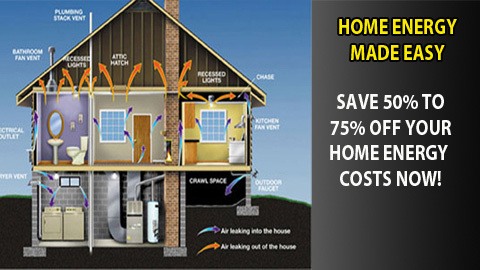Click Video to Watch
Course Summary: Energy Efficient Windows
The most important thing you need to take away from this lesson is…
Today's energy efficient windows can maximize daylight can add needed and necessary light, as well as heat, bringing your overall lighting and heating costs down even more. Windows and skylights could be your answer..

Daylighting and Energy Efficient Windows
Daylighting is the use of windows and skylights to bring sunlight into your home.
Today's highly energy efficient windows, as well as advances in lighting design, allow efficient use of windows to reduce the need for artificial lighting during daylight hours without causing heating or cooling problems.
The best way to incorporate daylighting in your home depends on your climate and home's design. The sizes and locations of windows should be based on the cardinal directions rather than their effect on the street-side appearance of the house.

South-facing windows are most advantageous for daylighting and for moderating seasonal temperatures. They allow most winter sunlight into the home but little direct sun during the summer, especially when properly shaded.
North-facing windows are also advantageous for daylighting. They admit relatively even, natural light, producing little glare and almost no unwanted summer heat gain.
Although east- and west-facing windows provide good daylight penetration in the morning and evening, respectively, they should be limited. They may cause glare, admit a lot of heat during the summer when it is usually not wanted, and contribute little to solar heating during the winter.
Passive Solar Window Design
Properly designed, energy efficient windows represent a cost-effective way to use solar energy for heating.
Windows are an important element in passive solar home designs, which can reduce heating, cooling, and lighting needs in a house.
Passive solar design strategies vary by building location and regional climate. The basic techniques involving windows remain the same—select, orient, and size glass to control solar heat gain along with different glazings usually selected for different sides of the house (exposures or orientations). For most U.S. climates, you want to maximize solar heat gain in winter and minimize it in summer.
Heating-Dominated Climates

In heating-dominated climates, major glazing areas should generally face south to collect solar heat during the winter when the sun is low in the sky. In the summer, when the sun is high overhead, overhangs or other shading devices (e.g., awnings) prevent excessive heat gain.
To be effective, south-facing windows usually must have a solar heat gain coefficient (SHGC) of greater than 0.6 to maximize solar heat gain during the winter, a U-factor of 0.35 or less to reduce conductive heat transfer, and a high visible transmittance (VT) for good visible light transfer.
Windows on east-, west-, and north-facing walls are reduced in heating climates, while still allowing for adequate daylight. East- and west-facing windows are limited because it is difficult to effectively control the heat and penetrating rays of the sun when it is low in the sky. These windows should have a low SHGC and/or be shaded. North-facing windows collect little solar heat, so they are used just to provide useful lighting.
Low-emissivity window glazing can help control solar heat gain and loss in heating climates.
Cooling-Dominated Climates
In cooling climates, particularly effective strategies include preferential use of north-facing windows and generously shaded south-facing windows. Windows with low SHGCs are more effective at reducing cooling loads. The following types of glazing help reduce solar heat gain, lowering a window's SHGC:
Improving the Energy Efficiency of Existing Windows

You can improve the energy efficiency of existing windows by doing the following:
- Adding storm windows
Reduce air leakage and some heat transfer
- Caulking and weather stripping
Reduce air leakage around windows
- Using window treatments or coverings
Reduce heat loss and/or gain
However, if your home has very old and/or inefficient windows, it might be more cost effective to replace them than to make these improvements. New, energy efficient windows eventually pay for themselves through lower heating and cooling costs, and sometimes even lighting costs.
Adding Storm Windows
If you have old windows in your home, the best way to improve your home's energy efficiency is to replace them with new, energy efficient windows. However, if you're on a tight budget, a less expensive option is to use storm windows. Some types of storm windows are also a good option for those living in apartments.
Even though storm windows add little to the insulating performance of single-glazed windows (that are in good condition,) field studies have found that they can help to reduce air movement into and out of existing windows. Therefore, they help reduce heating and cooling costs.
Window Treatments and Coverings

You can choose window treatments or coverings not only for decoration but also for saving energy. Some carefully selected window treatments can reduce heat loss in the winter and heat gain in the summer. They include the following:
- Awnings
- Blinds
- Draperies
- High-reflectivity films
- Insulated panels
- Mesh window screens
- Overhangs
- Shades
- Shutters
- Storm panels.
Window treatments, however, aren't effective at reducing air leakage or infiltration. You need to caulk and weather strip around windows to reduce air leakage.
Skylight Design Considerations
Before selecting a skylight for your home, you need to determine what type of skylight will work best and where to improve your home's energy efficiency.
Energy Performance
First, it's a good idea to understand the energy performance ratings of skylights if you don't already. You can then determine what energy performance ratings you need for your skylight based on your climate and home's design.
For labeling energy efficient windows and skylights, ENERGY STAR® has established minimum energy performance rating criteria by climate. However, this criteria doesn't account for a home's design. Therefore, if you're constructing a new home or doing some major remodeling, you should also take advantage of the opportunity to incorporate your skylight design and selection as an integral part of your whole-house design—an approach for building an energy-efficient home.

Size and Position
The physical size of the skylight greatly affects the illumination level and temperature of the space below. As a rule of thumb, the skylight size should never be more than 5% of the floor area in rooms with many windows and no more than 15% of the room's total floor area for spaces with few windows.
What you can do starting today
· First consider if the primary purpose is lighting and/or passive heating.
· Remember: Skylights on north-facing roofs provide cool illumination, while east-facing roofs provide maximum light and heat in the morning. West-facing skylights provide afternoon sunlight and heat. South-facing skylights provide more passive solar heat than any other location.
· Carefully study the southerly exposures of both your roof and exterior walls.
· Carefully consider the tilt of the skylight: A low-slope will admit relatively more solar heat in the summer and less in the winter, exactly the opposite of what is desirable.
· As always, examine your lifestyle. Inspect your windows. If even after air sealing you’re still experiencing air/heat loss, it may be time to replace them. Consider an insulated drapes and/or other window treatments as a low cost way to control heat/cooling loss.
· Carefully look at the orientation of your house. Do you have a lot of southern exposure? Is your roof able to support the use of skylights?
· Talk to some professionals: Energy efficient windows could possibly be a big expenditure. Get advice and estimates from professionals if you’re even considering it. Keep in mind, window treatments such as awnings, movable insulation, windows films, can do a lot instead replacing windows or installing skylights.
Checklists, Cheat sheets,...

